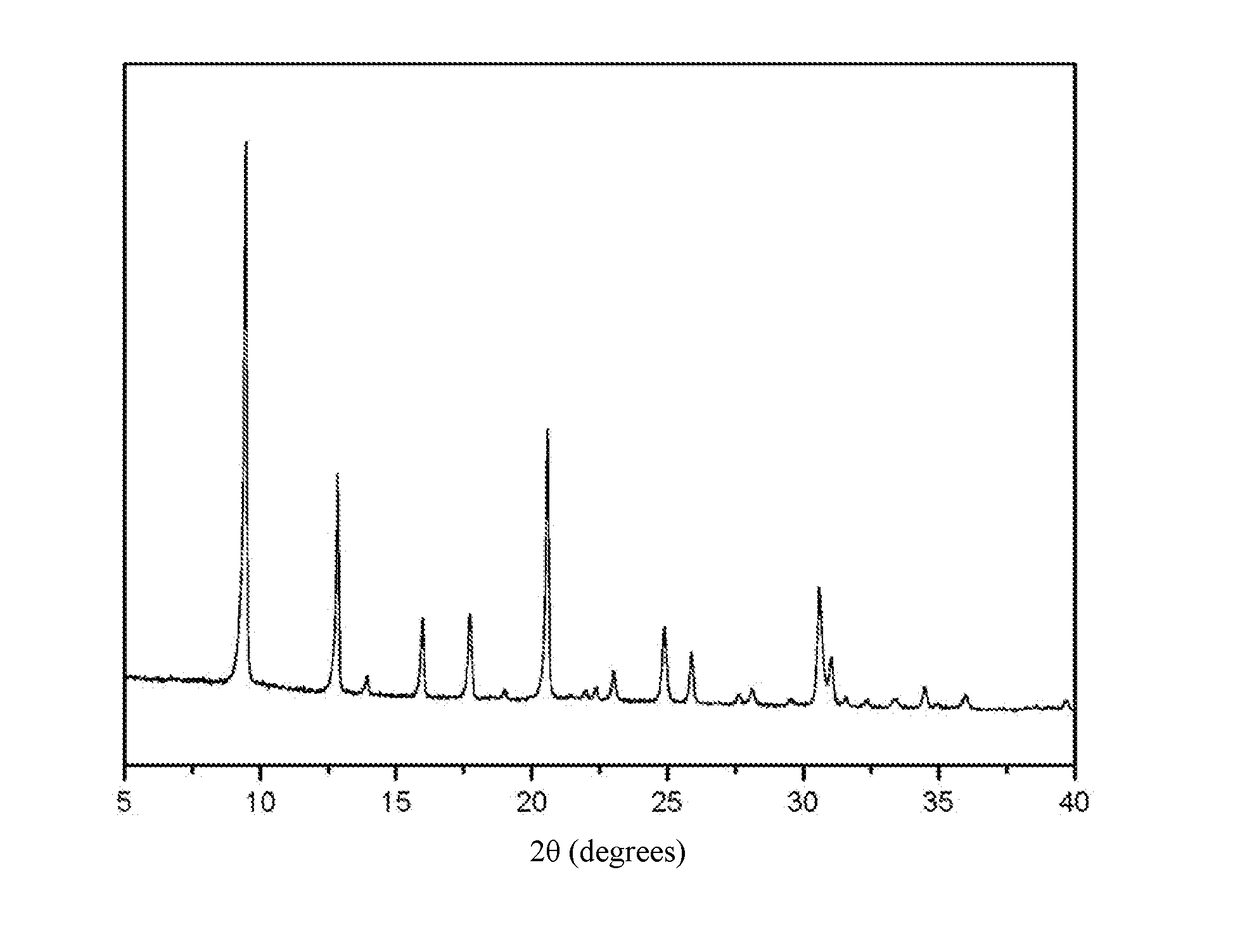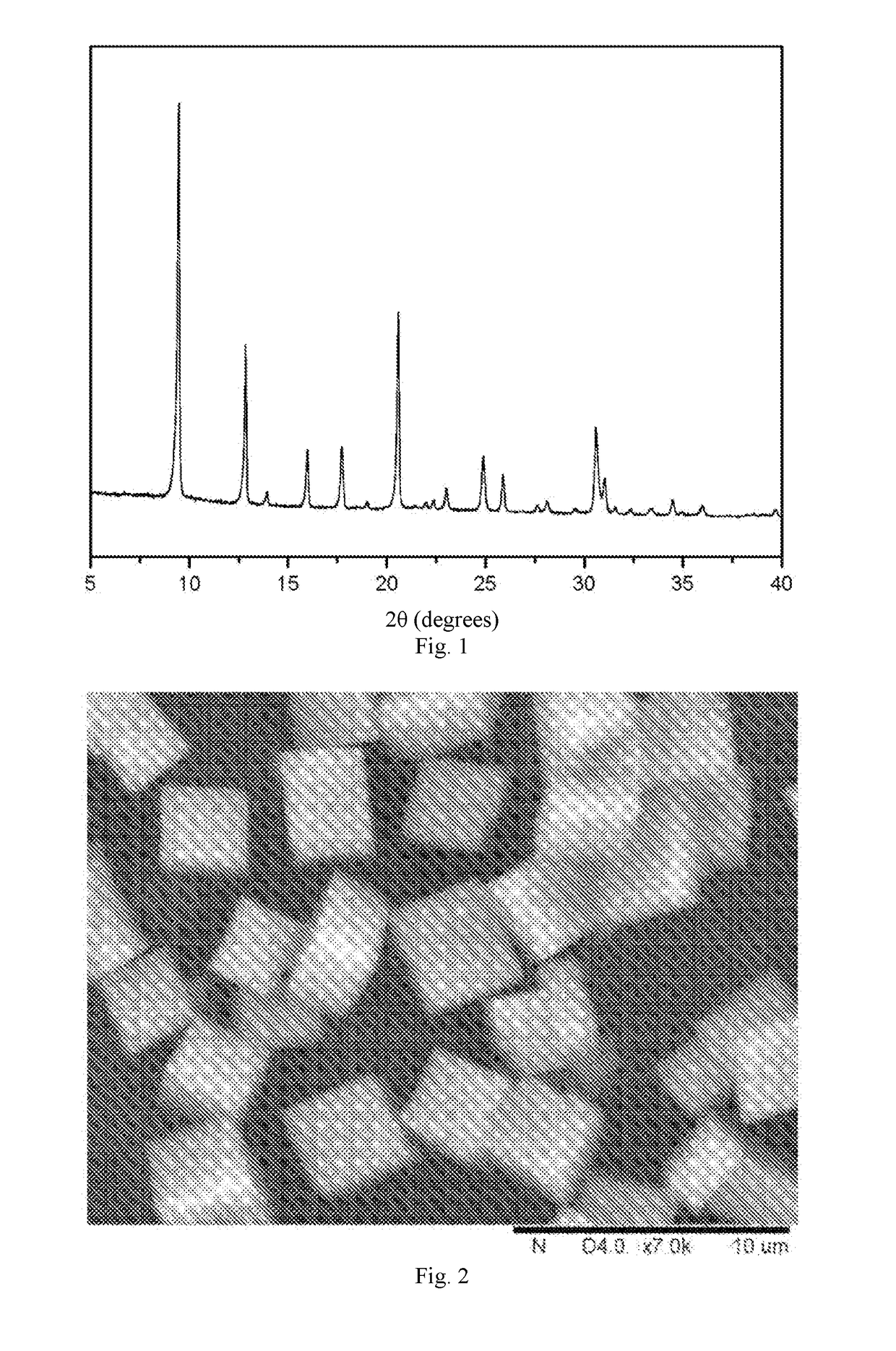Method for preparing acetal carbonyl compound
- Summary
- Abstract
- Description
- Claims
- Application Information
AI Technical Summary
Benefits of technology
Problems solved by technology
Method used
Image
Examples
example 1
[0056]At room temperature, pseudo-boehmite was added into a phosphoric acid solution, stirring for 2 h to obtain a homogeneous gel. Then silica sol and diethylamine (DEA) was added into the homogeneous gel, stirring for 3 h to obtain a gel mixture with a molar ratio of 2.0 DEA:0.6 SiO2:1.0 Al2O3:0.8 P2O5:50 H2O. The gel mixture was put into a crystallization kettle with a polytetrafluoroethylene lining, and then crystallized for 2 days at 200° C. After finishing the crystallization and being cooled, the solid product was centrifugal separated, dried at 120° C., and then was put into a muffle furnace and calcined at 550° C. in air for 4 h to obtain a SAPO-34 molecular sieve raw powder sample with chemical composition of (Si0.16Al0.48P0.36)O2. The SAPO-34 molecular sieve raw powder sample was calcined at 500° C. in air for 4 h to obtain an acidic SAPO-34 molecular sieve. The X-ray powder diffraction spectra and the scanning electron microscope image of the acidic SAPO-34 molecular sie...
example 2
[0057]Aluminium isopropoxide, deionized water, phosphoric acid and tetraethoxysilane (TEOS) were mixed and stirred for 3 h at room temperature to obtain a homogeneous gel. Then cetyl trimethyl ammonium bromide (CTAB) and diethylamine (DEA) solution were added into the homogeneous gel to obtain a gel mixture with a molar ratio of 2.0 DEA:1.0 Al2O3:0.8P2O5:0.4 TEOS:0.2 CTAB:100 H2O. The gel mixture was put into a crystallization kettle with a polytetrafluoroethylene lining, and then crystallized for 1 day at 200° C. After finishing the crystallization and being cooled, the solid product was centrifugal separated, dried at 120° C., and then was put into a muffle furnace and calcined at 550° C. in air for 4 h to obtain a DNL-6 molecular sieve raw powder sample with chemical composition of (Si0.14Al0.37P0.49)O2. The DNL-6 molecular sieve raw powder sample was calcined at 500° C. in air for 4 h to obtain an acidic DNL-6 molecular sieve. The acidic DNL-6 molecular sieve was molded using si...
example 3
[0058]At room temperature, pseudo-boehmite was added into a phosphoric acid solution, stirring for 2 h to obtain a homogeneous gel. Then silica sol and diethylamine (DEA) was added into the homogeneous gel, stirring for 3 h to obtain a gel mixture with a molar ratio of 2.0 DEA:0.6 SiO2:1.0 Al2O3:0.8 P2O5:50 H2O. The gel mixture was put into a crystallization kettle with a polytetrafluoroethylene lining, and then crystallized for 2 days at 200° C. After finishing the crystallization and being cooled, the solid product was centrifugal separated, dried at 120° C., and then was put into a muffle furnace and calcined at 550° C. in air for 4 h to obtain a SAPO-34 molecular sieve raw powder sample with chemical composition of (Si0.16Al0.48P0.36)O2. The SAPO-34 molecular sieve raw powder sample was ion-exchanged with 0.8 mol / L aqueous solution of ammonium nitrate at 80° C. for 3 times, to obtain an ammonium type SAPO-34 molecular sieve. The ammonium type SAPO-34 molecular sieve was ion-exch...
PUM
| Property | Measurement | Unit |
|---|---|---|
| Temperature | aaaaa | aaaaa |
| Temperature | aaaaa | aaaaa |
| Temperature | aaaaa | aaaaa |
Abstract
Description
Claims
Application Information
 Login to View More
Login to View More - R&D
- Intellectual Property
- Life Sciences
- Materials
- Tech Scout
- Unparalleled Data Quality
- Higher Quality Content
- 60% Fewer Hallucinations
Browse by: Latest US Patents, China's latest patents, Technical Efficacy Thesaurus, Application Domain, Technology Topic, Popular Technical Reports.
© 2025 PatSnap. All rights reserved.Legal|Privacy policy|Modern Slavery Act Transparency Statement|Sitemap|About US| Contact US: help@patsnap.com


